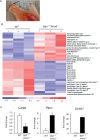Role of subchondral bone during early-stage experimental TMJ osteoarthritis
- PMID: 21917603
- PMCID: PMC3188464
- DOI: 10.1177/0022034511421930
Role of subchondral bone during early-stage experimental TMJ osteoarthritis
Abstract
Temporomandibular joint osteoarthritis (TMJ OA) is a degenerative disease that affects both cartilage and subchondral bone. We used microarray to identify changes in gene expression levels in the TMJ during early stages of the disease, using an established TMJ OA genetic mouse model deficient in 2 extracellular matrix proteins, biglycan and fibromodulin (bgn(-/0)fmod(-/-)). Differential gene expression analysis was performed with RNA extracted from 3-week-old WT and bgn(-/0)fmod(-/-) TMJs with an intact cartilage/subchondral bone interface. In total, 22 genes were differentially expressed in bgn(-/0)fmod(-/-) TMJs, including 5 genes involved in osteoclast activity/differentiation. The number of TRAP-positive cells were three-fold higher in bgn(-/0)fmod(-/-) TMJs than in WT. Quantitative RT-PCR showed up-regulation of RANKL and OPG, with a 128% increase in RANKL/OPG ratio in bgn(-/0)fmod(-/-) TMJs. Histology and immunohistochemistry revealed tissue disorganization and reduced type I collagen in bgn(-/0)fmod(-/-) TMJ subchondral bone. Early changes in gene expression and tissue defects in young bgn(-/0)fmod(-/-) TMJ subchondral bone are likely attributed to increased osteoclast activity. Analysis of these data shows that biglycan and fibromodulin are critical for TMJ subchondral bone integrity and reveal a potential role for TMJ subchondral bone turnover during the initial early stages of TMJ OA disease in this model.
Conflict of interest statement
The authors declare no potential conflicts of interest with respect to the authorship and/or publication of this article.
Figures



References
-
- Bailey AJ, Mansell JP, Sims TJ, Banse X. (2004). Biochemical and mechanical properties of subchondral bone in osteoarthritis. Biorheology 41:349-358 - PubMed
-
- Baron R, Neff L, Brown W, Louvard D, Courtoy PJ. (1990). Selective internalization of the apical plasma membrane and rapid redistribution of lysosomal enzymes and mannose 6-phosphate receptors during osteoclast inactivation by calcitonin. J Cell Sci 97(Pt 3):439-447 - PubMed
Publication types
MeSH terms
Substances
Grants and funding
LinkOut - more resources
Full Text Sources
Medical
Molecular Biology Databases
Miscellaneous

